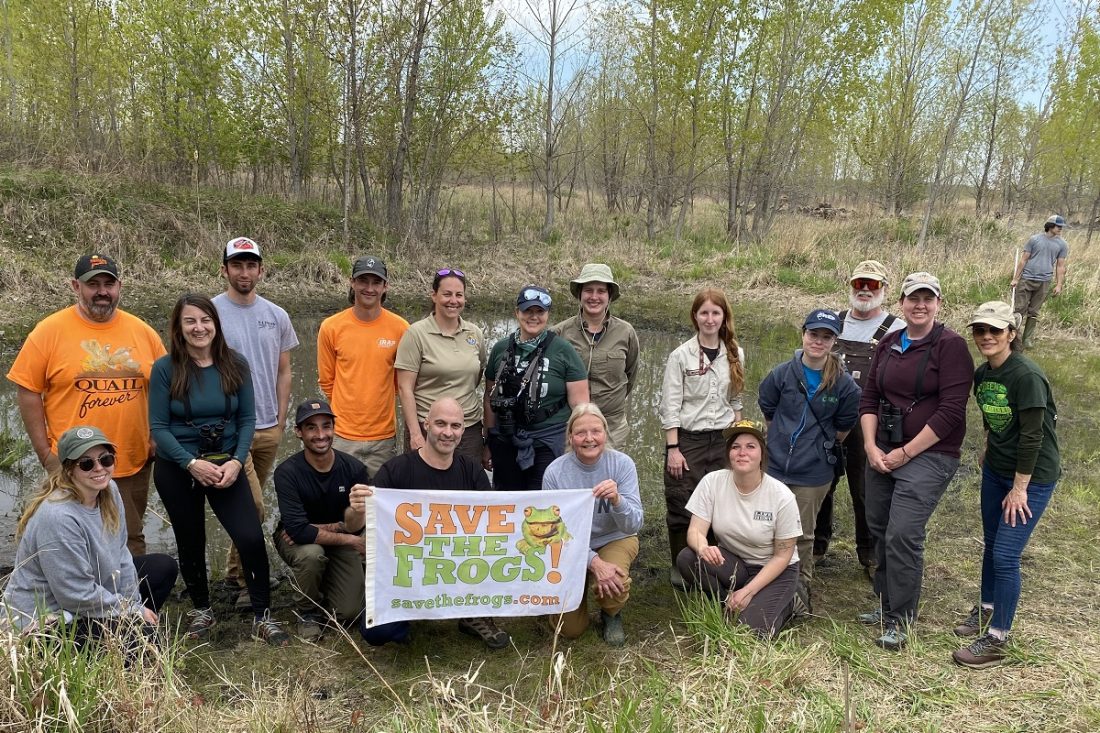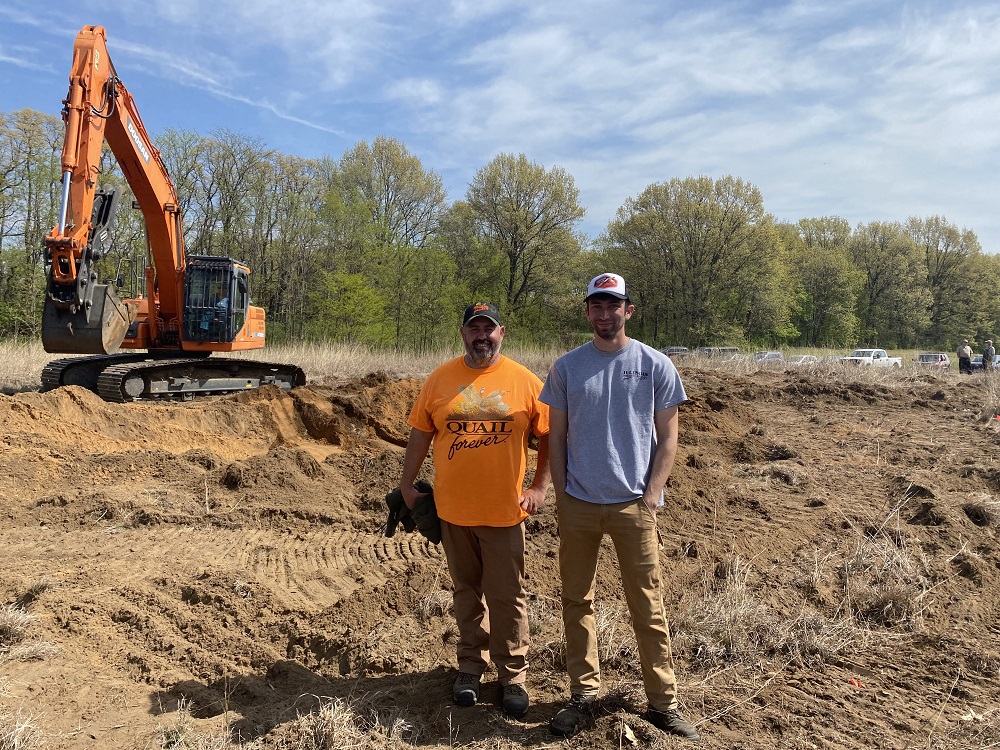
The Save the Frogs group. Photo courtesy USFWS.



The Save the Frogs group. Photo courtesy USFWS.
“Frog, Frog. Wake up, it’s spring!” shouted quail.
While you may not characterize frog and quail as friends, the Illinois chorus frog and northern bobwhite quail have a lot in common, particularly in the sand prairies of Illinois.

Bobwhite quail are a plump, non-migratory birds whose range covers much of the U.S. from the East Coast to the foothills of the Rocky Mountains. Quail were once found throughout Illinois, but today strong populations are found south of Interstate 70, notably in central, west central and southern Illinois. The Illinois chorus frog (ICF) has a much smaller population footprint. This rare, chubby frog with muscular forearms can only be found in isolated populations in west central and southwestern Illinois, southeastern Missouri and extreme northeastern Arkansas.

Sadly, both species are in decline. In Illinois, quail numbers are dropping by an average of 3.3 percent each year based on the North American Breeding Bird Survey. The Illinois chorus frog is also in peril. ICF is listed as state threatened in Illinois and is declining due to loss of breeding wetland habitat.
Although these species are struggling, each Illinois spring the quail’s iconic “bob-white” whistle can be heard in the same vicinity as the metallic-like call of the Illinois chorus frog. In these focused sand prairie areas, Pheasants Forever and Quail Forever (PFQF) Farm Bill Biologists are working with private landowners, the Illinois Department of Natural Resources (IDNR), and U.S. Fish and Wildlife Service (USFWS) to restore seasonal wetlands and enhance upland habitat.
Since fall of 2022, PFQF has been supporting IDNR and USFWS efforts to restore ICF breeding wetlands, which is no simple task.

Emily Hodapp, private lands biologist with the USFWS said, “For the most part, sand prairies don’t hold water. But! There are small pockets of hydric soils in the prairies that were once a sand prairie wetland oasis. Finding these dry wetland pockets in a landscape of sand can be like searching for a needle in a haystack. Unless, you have the right tools and proper training.”
To obtain this training, PFQF helped the USFWS host workshops lead by Tom Biebighauser, who specializes in restoring wetlands in sandy areas. Over the course of three wetland workshops, Biebighauser trained more than 50 people to restore wetlands benefiting the ICF. Attendees gained hands-on training and technical knowledge by building five wetlands at Meredosia National Wildlife Refuge.

Restoring wetlands is critical to recovering ICF populations, but quail will benefit from more ephemeral wetlands on the landscape, too. Ephemeral wetlands often hold water in the spring and fall but dry up in the summer months. These cyclical periods of water help to maintain early successional habitat in which quail flourish. As small prairie wetlands dry each summer, what remains is perfect feeding ground for young quail that can easily feed on insects scurrying through sparse vegetation in the wetland basin, or the quail can dart into the surrounding thicker vegetation for cover.
Upland habitat restoration is also important for the rebound of both ICF and bobwhite quail. ICF spend a few weeks a year breeding in wetlands, but most of their life is spent underground in the sand prairie upland areas. To burrow below the surface the frogs utilize their front feet to dig down through bare patches in the prairie. While the frogs are below ground all winter, quail find refuge in native prairie grasses and brush along the prairie edge.
While USFWS and IDNR are working to restore sand prairies and wetland on public lands, most of the recovery work must be accomplished on private lands. In studying ICF, Mark Alessi, IDNR Species Lead for the ICF Recovery Team, found “a significant private lands restoration program is needed to make an impact on declining ICF populations due to most of the ICF occurring on private lands.” Alessi and the ICF Recovery Team believe targeted conservation in partnership with private lands owners will help ICF populations bounce back.
“Organizations working with private landowners, like the USFWS Partners Program and PFQF, are crucial to recovering ICF in Illinois and across the species range in Missouri and Arkansas,” Alessi noted.

Pheasants Forever and Quail Forever employ the largest team of private lands biologists in the country. The goal of these biologists is to create quality habitat for not only ground-nesting birds but for all wildlife that benefits from varying stages of quality successional ecosystems. The Illinois team is present in 84 counties—and counting—to provide boots-on-the-ground assessments of existing habitat, as well as properties looking for direction in restoration. The biologist’s primary job is to determine a unique avenue for accomplishing the goals a landowner possesses for converting their property into exemplary habitat through partnering programs with agencies like the U.S. Department of Agriculture, IDNR and the USFWS. The team remains deeply committed to the installation and management of upland prairie habitat as well as the restoration of Illinois wetlands, providing technical assistance to critical areas. Landowners in high priority zones, such as the Central Illinois River Basin that consumes the native range of the Illinois Chorus Frog are encouraged to reach out to their local Pheasants Forever and Quail Forever Farm Bill Biologist to discover how the team can aid in your mission for quality habitat.
Without the partnering of private and governmental agencies, as well as the involvement of our private landowners, the conservation of these critical ecosystems would not be possible.
Brodie Eddington is a Farm Bill Wildlife Biologist for Pheasants Forever and Quail Forever in Illinois. Eddington has worked in central Illinois for the past two years and has recently transferred back to his home counties in western Illinois. He focuses on cultivating quality habitat with private landowners to benefit native plant and animal species. He has committed himself to working with local Pheasants and Quail Forever chapters to install native habitat as well as educate the public on its importance. Eddington’s coverage area consists of Hancock, Adams, McDonough, Schuyler and Brown counties. He can be reached at beddington@pheasantsforever.org.
Tom Branson is a Farm Bill Wildlife Biologist for Pheasants Forever and Quail Forever in Illinois. Branson has spent the last seven years as the coordinator for the Pheasants Forever Illinois Recreational Access Program (IRAP) Strike Team. He committed himself to managing quality habitat on private and public properties using prescribed fire as well as more hands-on removal of undesirable species. Branson transitioned to a Farm Bill Wildlife Biologist position in May of 2023. His coverage area consists of Cass, Mason, Fulton, Scott, Morgan and Pike counties. He can be reached at tbranson@pheasantsforever.org.
Submit a question for the author